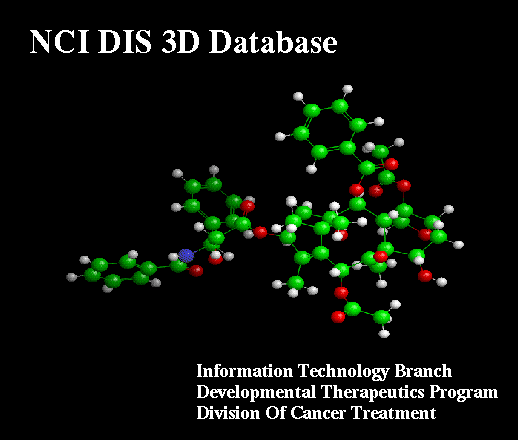
The NCI Drug Information System 3D Database
Background
The NCI DIS 3D database is a collection of 3D structures for over 400,000 drugs which was built
and is maintained by the Developmental Therapuetics
Program, Division of Cancer Treatment, National Cancer Institute, Rockville ,MD.
The database is an extension of the NCI Drug
Information System. The structural information stored in the DIS is only the
connection table for each drug. The connection table is just a list of which atoms
are connected and how they are connected. This information can be searched to find
drugs that share similar patterns of connections, which can correlate
with similar biological activity. But the cellular targets for drug action, as well as the
drugs themselves, are 3 dimensional objects and advances in computer hardware and
software have reached the point where they can be represented as such. In many cases the
important points of interaction between a drug and its target can be represented by a 3D
arrangement of a small number of atoms. Such a group of atoms is called a
pharmacophore.
The pharmacophore can be used to seach 3D databases and drugs that match the pharmacophore
could have similar biological activity, but have very different patterns of atomic
connections. Having a diverse set of lead compounds increases the chances of finding an active
compound with acceptable properties for clinical development.
Technical Description
The NCI DIS 3D Database was built using the program Chem-X.
An overview of the database build has been published:
Milne, G.W.A., Nicklaus, M.C., Driscoll, J.S., Wang, S. and Zaharevitz. D.
The NCI Drug Information System 3D Database. J. Chem. Inf. Comput. Sci.
in press (1994).
A more detailed description of particular procedures involved in the database build
can be acessed from the following list.
- The NCI Chem-X environment
- Extraction of the atomic connection information from the DIS
- Building the 3D structures
- A pre-key step to store good starting conformations in the database
- conformationally keying the database
Applications
The 3D database is being using for:
- 3D pharmacophore searches to discover novel active compounds
- Statistical investigations using the 3D distance keys


